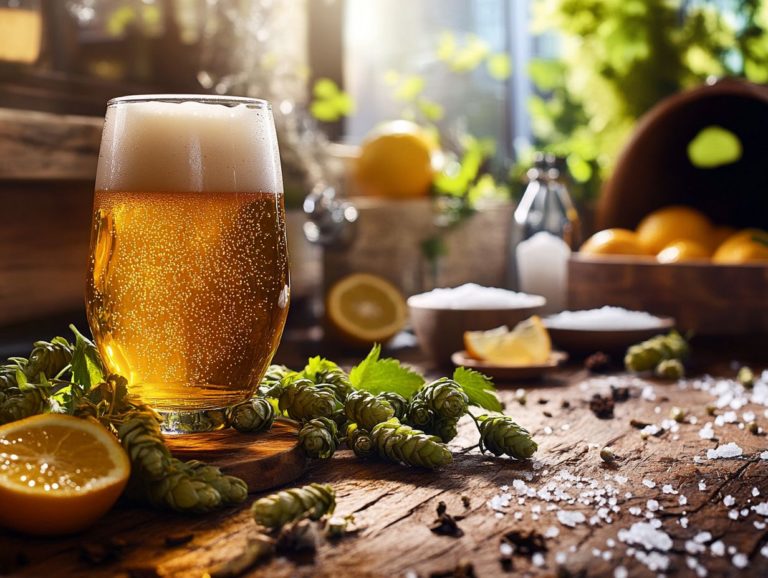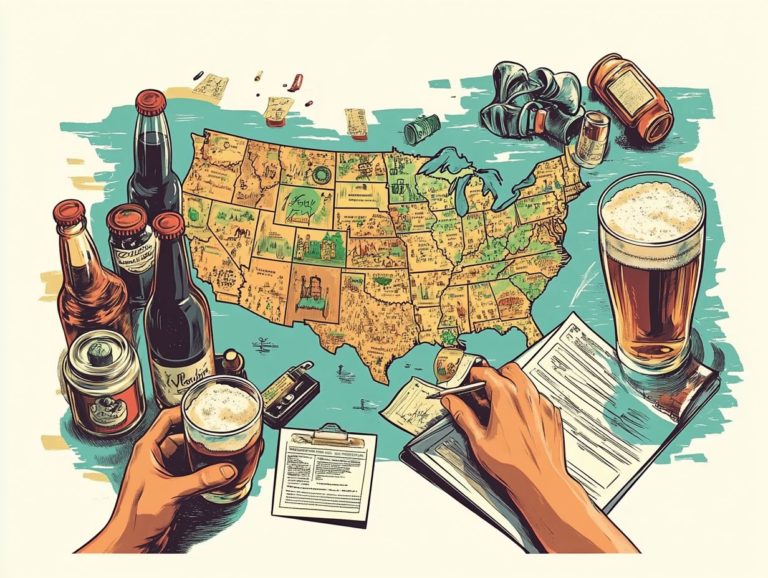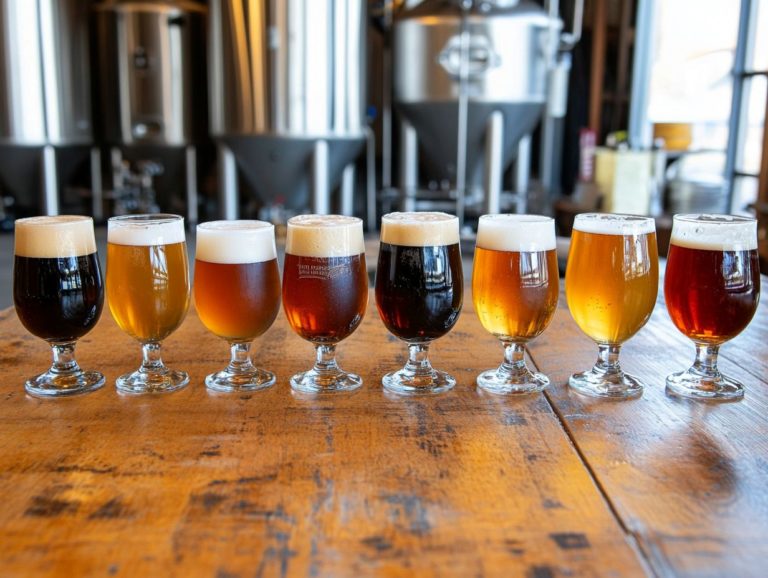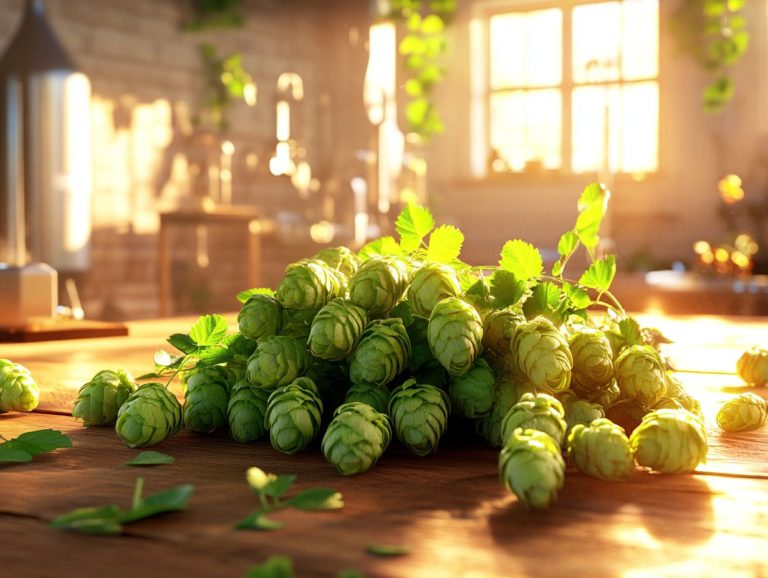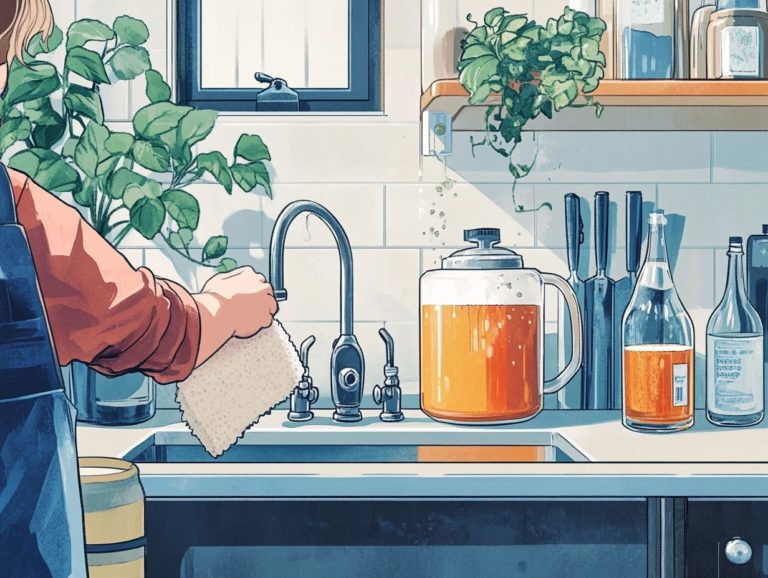How Do I Carbonate My Home Brewed Beer?
Carbonation is an essential element of beer brewing that enhances the texture of the drink and its flavor profile, leading to overall enjoyment! This process involves the dissolution of carbon dioxide (CO2) into the beer, giving it a delightful fizz.
This guide delves into the importance of carbonation in beer, the various methods to achieve it, and how you can successfully carbonate your home-brewed creations using different bottling techniques. Get ready to elevate your brewing game!
By grasping the distinctions between natural and forced carbonation, recognizing common pitfalls, and fine-tuning your carbonation levels, you ll discover valuable insights to ensure your beer is perfectly carbonated every time. This includes understanding the role of priming sugar, which is added to the beer to generate CO2 during fermentation, and carbonation drops in the process.
Contents
- Summary of Key Points
- Key Takeaways:
- What Is Carbonation?
- Why Is Carbonation Important in Beer?
- How Is Beer Carbonated?
- What Is Natural Carbonation?
- What Is Forced Carbonation?
- What Are the Different Methods of Carbonating Home Brewed Beer?
- Spunding Method
- What Factors Affect Carbonation in Beer?
- How Do I Know If My Beer Is Carbonated?
- What Are Some Common Mistakes When Carbonating Home Brewed Beer?
- How Can I Adjust the Carbonation in My Beer?
- Frequently Asked Questions
- What is carbonation and why is it important in home brewed beer?
- How do I know if my home brewed beer needs to be carbonated?
- What are the different methods for carbonating home brewed beer?
- How do I bottle condition my home brewed beer?
- Can I use any type of sugar for bottle conditioning my home brewed beer?
- Is it possible to overcarbonate my home brewed beer?
Summary of Key Points
Key Takeaways:
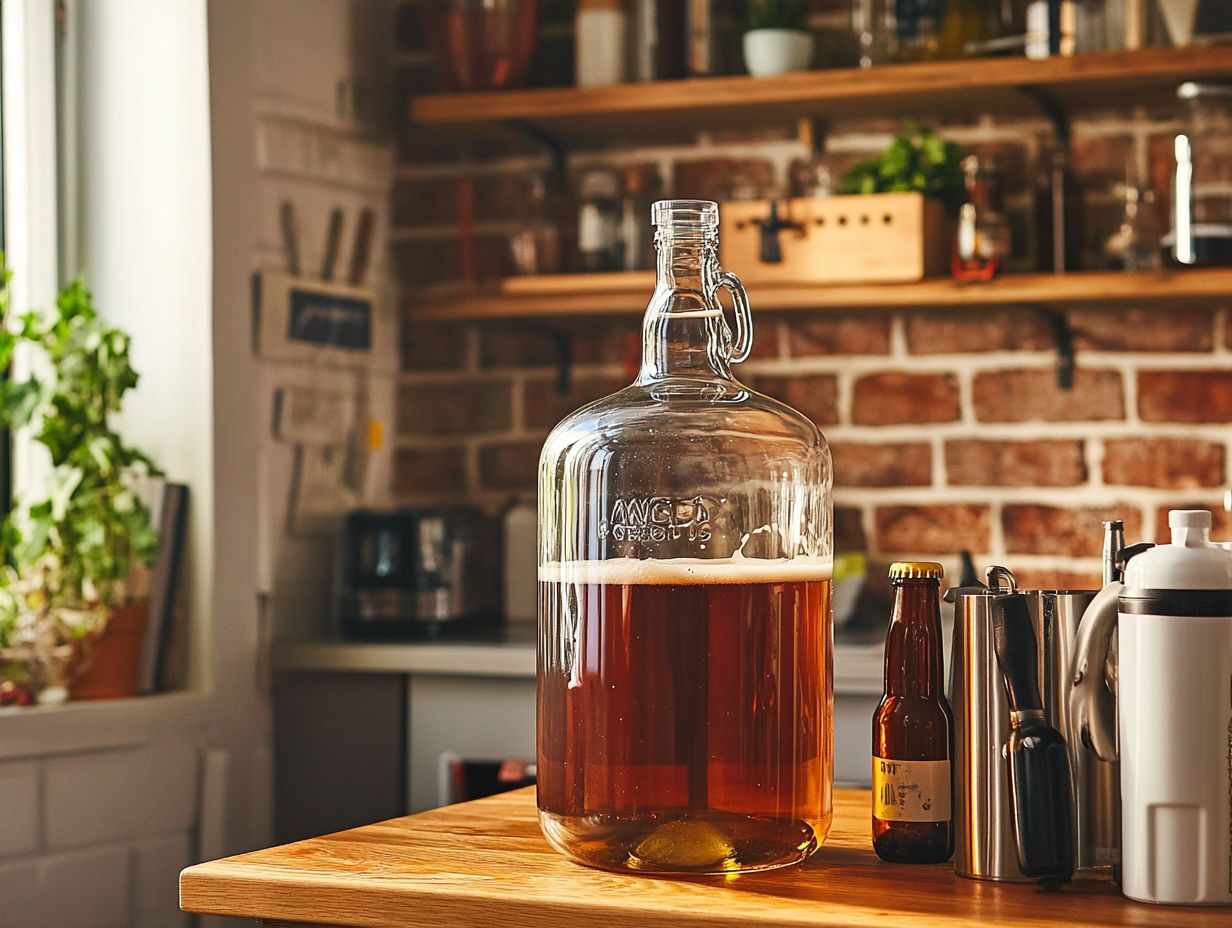
- Carbonation gives beer its fizz and plays a crucial role in its flavor and mouthfeel.
- Home brewers can choose between natural and forced carbonation methods to carbonate their beer, often using priming sugar or carbonation drops to achieve the desired effect.
- Factors like temperature, pressure, and method choice can affect the level of carbonation in home-brewed beer.
What Is Carbonation?
Carbonation is the art of dissolving carbon dioxide (CO2) gas into a liquid, and when it comes to beer, this process is essential for crafting the perfect mouthfeel and flavor profile. It takes place during fermentation when yeast feasts on sugar, producing alcohol and CO2 as delightful byproducts.
The presence of CO2 is critical in creating the fizz and avoiding flat beer. The level of carbonation has a significant impact on the beer’s overall quality, lending a refreshing fizz that elevates your drinking experience.
Proper carbonation is crucial; without it, your beer risks becoming flat, stripping away its allure especially in beloved styles like American Pale Ale, Pilsner, or those unique craft beers that are all about showcasing vibrant flavors.
Why Is Carbonation Important in Beer?
Carbonation is vital in the art of beer production, playing a significant role in shaping your sensory experience as you savor the drink. The presence of CO2 introduces a delightful fizz that enhances both flavors and aromas, elevating the overall mouthfeel.
This aspect is especially crucial in various beer styles, like Pilsner and English ales. Achieving the right level of carbonation can transform your tasting experience and ward off any flatness.
Proper carbonation levels ensure your beer’s stability and shelf life, making it an essential consideration for homebrewers and craft beer aficionados alike!
How Is Beer Carbonated?
You can achieve beer carbonation through various methods, each significantly influencing both the final product and the brewing process.
One of the most prevalent techniques is natural carbonation, where residual sugar from fermentation is harnessed, enabling the yeast to produce CO2 as it continues its work in the bottle or keg. On the other hand, there s forced carbonation, which involves directly adding CO2 gas to the beer in a keg, offering precise control over carbonation levels.
Each method presents its own set of benefits and challenges, making it crucial for you to grasp your options, including the use of priming sugar or carbonation drops if you’re looking into homebrewing.
What Is Natural Carbonation?
Natural carbonation is a captivating process where your beer develops carbonation through the ongoing fermentation of residual sugars by yeast, resulting in CO2 production. This method unfolds when you add a measured amount of priming sugar to the beer before bottling. The yeast then ferments once more in a sealed bottle, creating that delightful natural effervescence.
Not only does this technique contribute to the beer’s carbonation, but it also enhances its flavor profile. It is a favored choice among discerning homebrewers and craft beer aficionados.
The sugars you select for this process can vary. Corn sugar or dry malt extract are popular due to their fermentable nature. Some brewers also use lactose sugar for specific beer styles.
During this secondary fermentation, the yeast consumes these sugars, generating not only carbon dioxide but also additional flavor compounds that deepen the beer’s overall taste.
While natural carbonation is celebrated for enhancing flavor and aroma, it does have its risks. If fermentation isn t properly managed, you might end up with a flat beer lacking that intended sparkle. Therefore, achieving the right balance is essential to ensure your beer boasts lively bubbles while maintaining its rich and complex flavors.
What Is Forced Carbonation?
Forced carbonation is an advanced method used in brewing, where you introduce carbon dioxide (CO2) artificially into the beer, usually within a keg. This gives you the power to perfectly control your beer’s carbonation levels, achieving consistent and reliable results without depending solely on the fermentation process.
By applying pressure and forcing CO2 into the beer, you can rapidly carbonate your product. This technique is an efficient choice for both commercial breweries and homebrewers using kegging systems.
This method is often used in the US because it effectively achieves consistent carbonation levels. With the right equipment like CO2 tanks and regulators you can expertly manage the amount of gas infused into the liquid.
The process involves adjusting the regulator to set the correct pressure, which dictates how much CO2 will dissolve into the beer over time. This method not only speeds up the carbonation process but also enables you to fine-tune the level of fizz, enhancing the overall sensory experience of your final product.
However, while forced carbonation brings speed and precision to your brewing, it lacks the natural carbonation elements that develop during fermentation. These elements can contribute unique flavors and aromas, so you must carefully consider the benefits of rapid production against the traditional qualities that nature provides.
What Are the Different Methods of Carbonating Home Brewed Beer?
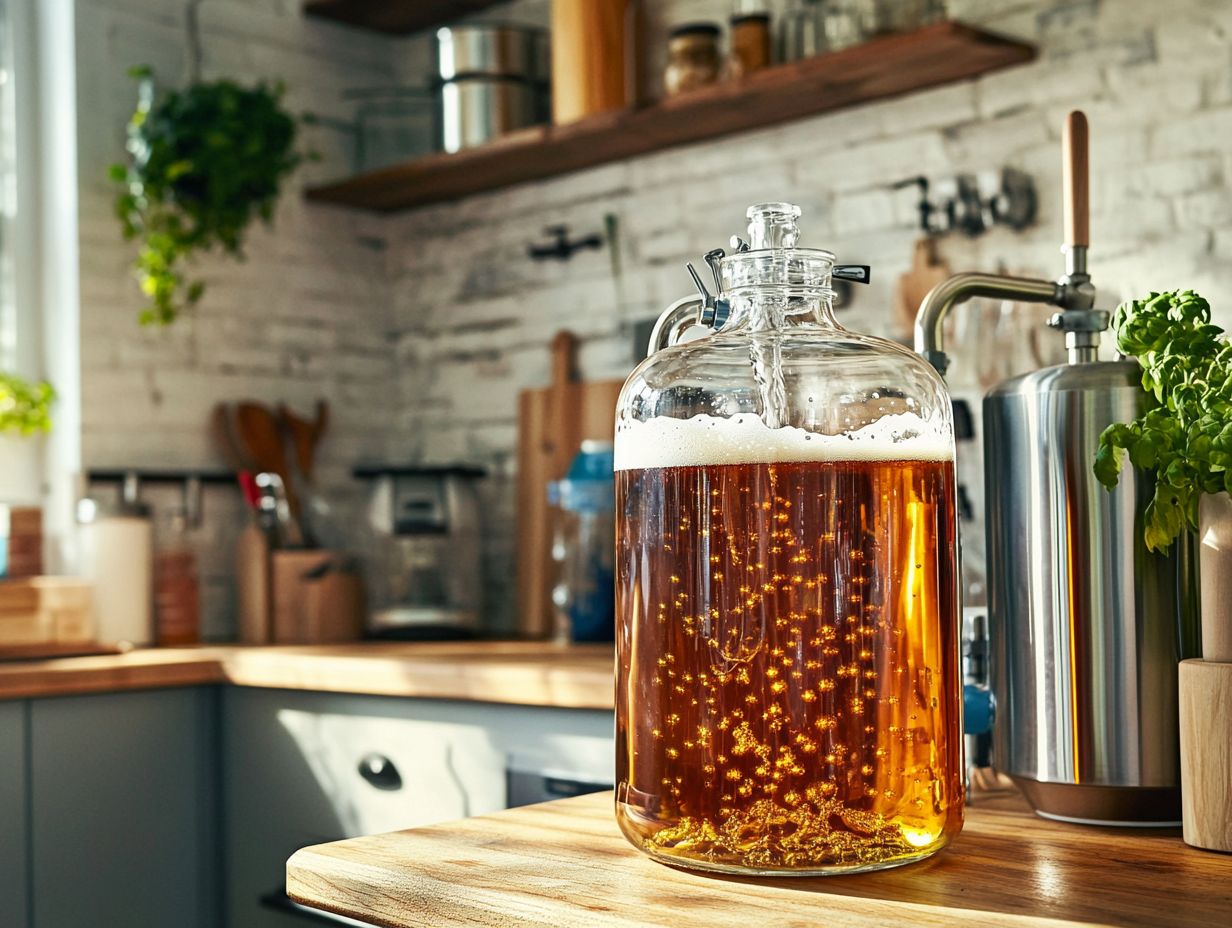
As a homebrewer, you have a range of methods at your fingertips for carbonating beer, each presenting its own unique advantages tailored to various brewing setups.
One widely embraced technique is the priming sugar method, where you add a precise quantity of sugar before bottling to promote natural carbonation.
Alternatively, the keg carbonation method employs CO2 tanks to force carbonation into your beer efficiently.
If you re looking for more control, the spunding method allows you to manage fermentation pressure with a spunding valve. This results in a naturally carbonated beer while minimizing the risk of over-carbonation. This method is often used in high gravity beers to ensure proper carbonation levels.
1. Priming Sugar Method
The priming sugar method is your ticket to achieving perfectly carbonated beer. By adding a calculated amount of sugar right before bottling, you allow the yeast to work its magic, fermenting the sugar and producing CO2 that carbonates your brew. This technique is especially popular among homebrewers for its simplicity and effectiveness in hitting that ideal carbonation level.
With careful measurement and attentive monitoring of fermentation, you can steer clear of common pitfalls like flat beer or the dreaded bottle bombs.
To get started, it s crucial to calculate the right amount of sugar based on your beer’s volume and your desired carbonation level, typically using a priming sugar calculator. Common choices for sugar include corn sugar or table sugar, each requiring precise measurements usually around 3/4 cup for a five-gallon batch.
Once you ve determined the sugar amount, boil it with water to create a simple syrup. This step not only helps dissolve the sugar but also ensures sanitation, which is paramount at every stage of the brewing process. Any contamination can lead to off-flavors or spoilage, and that’s the last thing you want. Use a proper sanitizer to ensure cleanliness.
Thoroughly clean all your equipment to ensure perfect results! Confirm that the fermentation process has fully completed before bottling to avoid potential pitfalls like over-priming or inconsistent carbonation. Consider using a bottling bucket to ease the process. Your dedication to these details will ensure that each bottle you pop open is a delightful experience.
2. Keg Carbonation Method
The keg carbonation method enables you to carbonate your beer swiftly and efficiently by harnessing pressurized CO2 from a tank. Seal your brew in a keg, then apply CO2 pressure to carbonate it perfectly, resulting in a consistent and stable product. Kegging also provides convenience for serving and storing your beer, making it a favored choice among craft beer aficionados. Investing in quality brewing equipment is key to this method.
To achieve optimal keg carbonation, it s wise to invest in a quality CO2 tank, regulator, and a proper kegging system. Chill the beer to the ideal temperature, make sure it s clean, and then carefully transfer it to the keg.
Once sealed, introduce CO2 at a specific pressure, which you can adjust based on your desired carbonation level. This method not only enhances the flavor profile of your beer but also streamlines the serving process, freeing you from the tedium of bottling.
Kegging can truly elevate your brewing experience, offering efficient storage and quick access to that refreshing, freshly carbonated brew.
Spunding Method
The spunding method is an innovative approach to carbonation that you ll find intriguing. By utilizing a spunding valve on your fermentation vessel, you can expertly control the pressure during fermentation, allowing for natural carbonation to happen seamlessly. This method lets you manage the pressure within the vessel, preventing over-carbonation while still enabling the yeast to produce CO2. The result? A beer that s not only naturally carbonated but also packed with flavor. It’s no wonder this technique is the preferred choice for homebrewers looking for a balance of convenience and tradition, similar to classic brewing techniques used in styles like Pilsner and English ale.
Employing a spunding valve not only streamlines the carbonation process but also elevates the depth of flavor and sugar conversion often comparable to craft beer made using dry malt extract or malt extract in your final product. The essential brewing equipment you ll need includes a fermentation vessel and bottling bucket equipped with a spunding valve, along with the usual fermentation tools you already have on hand.
One of the standout benefits of natural carbonation is how it often leads to a smoother mouthfeel and a refined finish, reducing the risk of bottle bombs that traditional bottling methods can bring. This approach drastically reduces the need for sugars added before bottling to assist with carbonation, resulting in a more organic brewing experience. As you explore this method, you ll discover it yields a more refined and authentic beer that bridges the gap between classic techniques and modern brewing practices, similar to those taught at the Institute of Brewing and Distilling.
What Factors Affect Carbonation in Beer?
Several factors can profoundly affect the carbonation level, utilizing tools like an online calculator for your beer, with temperature and pressure standing out as the most crucial elements in both natural and forced carbonation methods.
Temperature significantly influences the solubility of CO2 and yeast activity in your brew. Higher temperatures often lead to diminished carbonation retention, while cooler temperatures enhance CO2 absorption. Pressure is just as significant, directly influencing the amount of CO2 that can be absorbed by the beer during the carbonation process.
1. Temperature
Temperature is crucial in the carbonation process of beer, influencing both fermentation and carbonation, as well as the solubility of CO2. Maintaining an optimal temperature is essential for yeast activity, which directly affects sugar conversion and CO2 production. The serving temperature can significantly impact how you perceive carbonation; colder temperatures enhance CO2 retention and yeast activity, while warmer ones may leave your beer tasting a bit flat.
For homebrewers, grasping these dynamics can lead to more successful brews. The optimal fermentation temperatures typically range from 65 F to 75 F (18 C to 24 C) for ales, while lagers favor cooler settings of around 45 F to 55 F (7 C to 13 C).
It’s essential to monitor your fermentation environment. Employing temperature control methods like those discussed by beer writer David Ackley such as fermentation jackets or temperature-controlled chambers ensures your yeast remains active and efficient. When it’s time to serve, aim for a slightly cooler glass to enhance your drinking experience, allowing the carbonation to shine while sidestepping excessive foaming that often comes from overly warm temperatures.
2. Understanding Pressure in Beer Carbonation
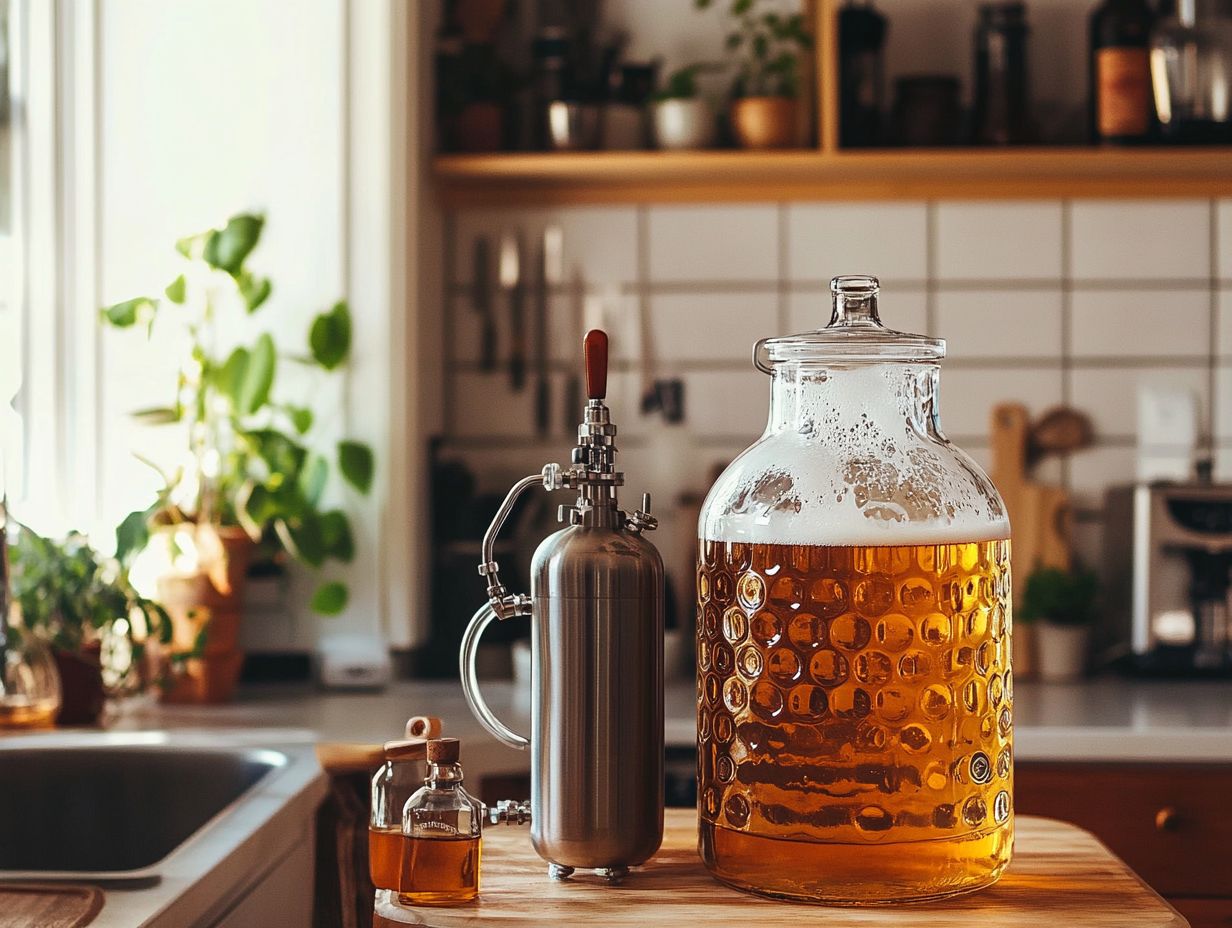
Pressure plays a pivotal role in the carbonation of beer, especially when you’re using forced carbonation methods in a keg. By fine-tuning the pressure inside the keg or beer bottles, you can control how much CO2 dissolves in the sugar solution in your brew, directly affecting its carbonation level. Managing pressure precisely helps you achieve effervescence. It also prevents issues like over-carbonation and bottle bombs.
Grasping the relationship between pressure and carbonation is crucial for you as a homebrewer, particularly when weighing the differences between kegging and bottling. With kegging, using a regulator allows for those meticulous adjustments, making it simpler to attain consistent carbonation levels.
If you lean towards bottling, be aware that higher pressure can lead to excessive carbonation, which might result in surprises when you open a bottle. Regularly monitoring pressure gauges and carbonation charts will offer you valuable insights. It s wise for you to experiment with varying pressures and take diligent notes on how each batch reacts, ultimately honing your technique for achieving perfect carbonation every single time.
3. Carbonation Method
The method you choose for carbonation plays a pivotal role in determining both the final carbonation level using a priming solution and the flavor profile of your beer. This is crucial for brewers aiming for specific tastes or textures.
On one hand, forced carbonation allows for a quicker turnaround, letting you enjoy your product sooner. However, it can strip away some of the subtle flavors that develop naturally during fermentation. On the other hand, natural carbonation can enhance the depth and complexity of your beer, as the yeast not only generates those delightful bubbles but also contributes to the overall aromatic profile of your brew, especially in high gravity brews.
While this method may require additional time and careful monitoring to prevent over-carbonation or off-flavors, the results can be well worth the effort.
Ultimately, selecting the right carbonation method hinges on the type of beer being brewed, whether it be an American Pale Ale, German weissbier, or Belgian blond you re brewing. Each style may benefit from the unique characteristics that different approaches offer.
How Do I Know If My Beer Is Carbonated?
Determining whether your beer is properly carbonated can be easily accomplished through a few straightforward methods designed to assess its carbonation level. One effective approach is to use a hydrometer, a tool to measure the specific gravity of liquids; if fermentation is complete and you observe no further gravity changes, your beer is likely well-carbonated. Visual cues such as bubbles forming upon pouring signal carbonation levels. A flat beer often indicates insufficient carbonation.
Proper carbonation is vital, as it influences not only the beer s mouthfeel but also its aroma and flavor release. When carbonation reaches the optimal level, it elevates the sensory experience, transforming your beverage into something refreshing and lively.
You might also take note of the beer s head retention and the rate at which bubbles rise. A persistent foamy head is a good indicator of sufficient carbonation, enhancing both the visual appeal and the aromatic experience.
Establishing the right levels of carbonation can significantly impact the quality and overall enjoyment of your final product, making it essential for both brewers and enthusiasts alike. Finding the perfect carbonation can elevate your brewing game and make each sip a delightful experience! Don t hesitate to try different techniques to discover what works best for your brew!
What Are Some Common Mistakes When Carbonating Home Brewed Beer?
Homebrewing presents exciting opportunities, yet it s fraught with potential pitfalls, especially during the carbonation process. You may encounter issues like flat beer or, worse, bottle bombs. One common misstep is calculating incorrectly the amount of priming sugar needed. This could leave your brew lacking carbonation or create dangerous pressure buildup.
Neglecting proper sanitation can invite unwanted contaminants that disrupt both fermentation and carbonation. To sidestep these issues, it s wise to invest in precise measuring tools that help you achieve the accurate dosages of your ingredients. Utilizing a priming sugar calculator can simplify this process, ensuring you get the right amounts tailored to your batch size and beer style.
Furthermore, using strong cleaning methods like thoroughly cleaning all utensils and fermenters with the right cleaners and sanitizers is crucial for keeping undesirable bacteria at bay and protecting your brew. By honing in on these essential steps, you can dramatically boost your chances of crafting a perfectly carbonated beverage which is lively and refreshing without relying on lactose. Ultimately, this will transform your homebrewing experience into something truly enjoyable.
How Can I Adjust the Carbonation in My Beer?
Adjusting the carbonation level in your beer is essential for achieving that perfect taste, carbonation level, and mouthfeel. There are several methods you can use, whether you re dealing with kegged or bottled beer. If you re working with a keg, increasing the pressure can elevate the carbonation levels, while releasing some pressure can help if things are feeling a bit too fizzy.
For bottled beer, if you find that the carbonation is lacking, adding a small amount of priming sugar to your existing brew and resealing it can work wonders in achieving the desired effervescence. Keep a close watch on the fermentation process for the best results!
When kegging, adjusting the CO2 pressure typically around 10-12 PSI for most ales will enable you to control the carbonation rate effectively. For bottles, a gentle roll can help distribute the priming sugar evenly, promoting consistent carbonation throughout.
Temperature matters! Warmer beer absorbs CO2 quickly, while cooler beer will take its time to reach that ideal level. Paying attention to these details will lead to a more refined and enjoyable drinking experience that you can truly savor.
Frequently Asked Questions
What is carbonation and why is it important in home brewed beer?
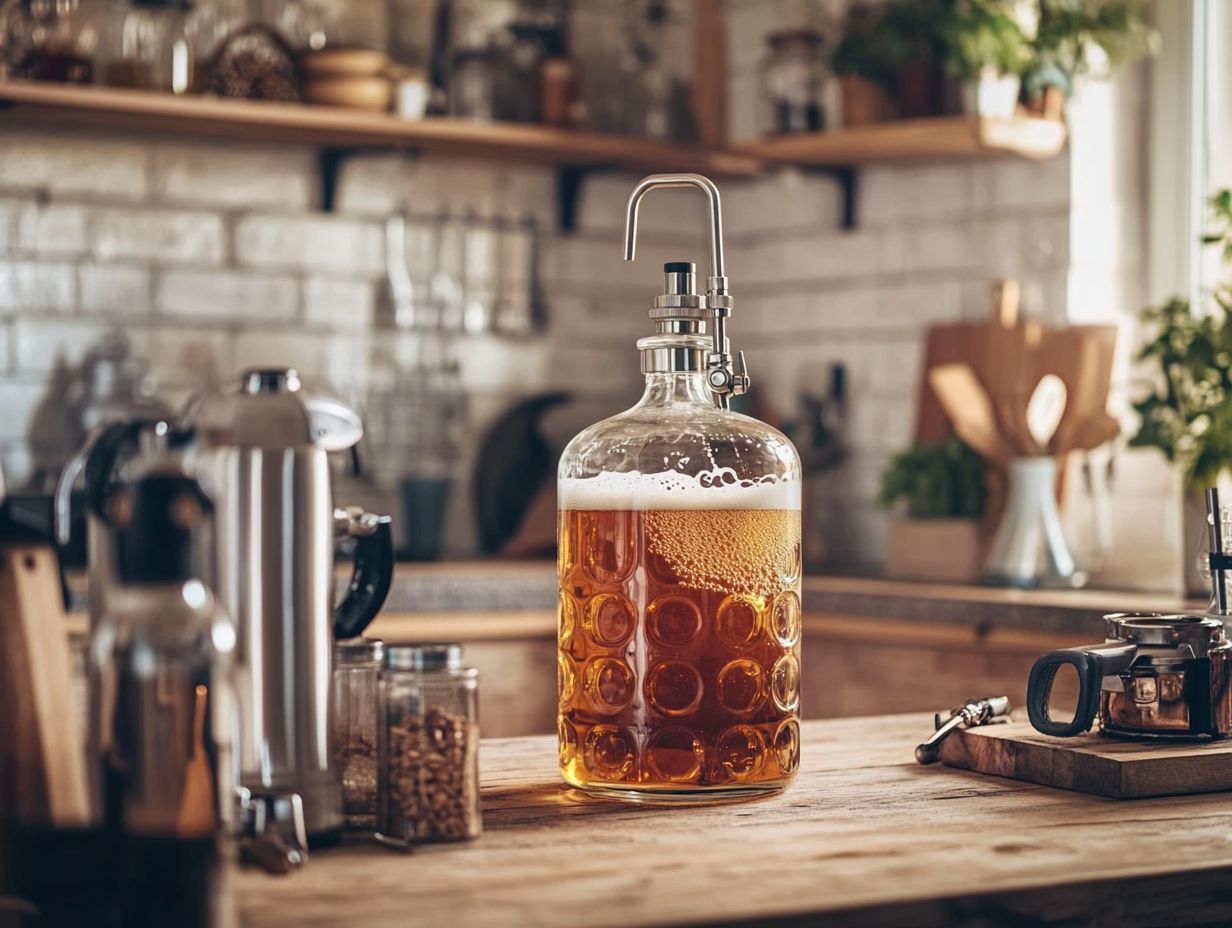
Carbonation is the process of adding carbon dioxide (CO2) to beer, creating the bubbles and fizziness that we associate with beer. It is important in homebrewing because it adds to the overall flavor and mouthfeel of the beer, making it more enjoyable to drink. It is also crucial in various beer styles, such as American Pale Ale, Pilsner, and German weissbier.
How do I know if my home brewed beer needs to be carbonated?
To ensure your beer has the right level of carbonation, you can use a carbonation level chart. Additionally, certain beer styles, like English ale or Belgian blond, may require specific carbonation techniques.
If your home brewed beer is lacking in bubbles and has a flat taste, often referred to as flat beer, it is likely that it needs to be carbonated. You can also check the specific gravity of your beer using a hydrometer if it has reached its final gravity, it is ready to be carbonated. Gravity measurement is essential in determining the readiness for carbonation.
What are the different methods for carbonating home brewed beer?
Dry yeast is useful for bottle conditioning, especially if the fermentation vessel has insufficient yeast. You can find various bottling techniques at your local brewing shop or online.
The most common methods for adding fizz to home brewed beer include bottle conditioning, force carbonation with a CO2 tank, and natural carbonation in a keg. Each method has unique advantages, so pick one that suits you best!
Various brewing equipment can aid in these processes. Using an online calculator will help you determine the perfect carbonation level.
How do I bottle condition my home brewed beer?
Proper sanitization is crucial. Make sure your beer bottles are clean and choose either pop-off or twist-off caps based on your preference and equipment.
To bottle condition, add a small amount of sugar to your beer before bottling. The yeast will consume this sugar, producing CO2 and creating fizz in the bottle.
You can use priming sugar or corn sugar for this. After bottling, let your beer sit at room temperature for 1-2 weeks to carbonate fully. Using a bottling bucket and wand can simplify this process.
Can I use any type of sugar for bottle conditioning my home brewed beer?
When choosing sugar, consider dry malt extract or lactose for different flavor profiles. While some brewers recommend table sugar, it’s best to use priming sugar for consistent carbonation.
Priming sugar is specifically measured for predictable results. A priming solution ensures even better accuracy.
Is it possible to overcarbonate my home brewed beer?
Yes, it is indeed possible to overcarbonate your beer. This happens if you use too much sugar or let the beer sit at room temperature for too long, which can lead to exploding bottles.
To avoid this, follow proper guidelines and use the correct amount of sugar solution. Patience is the key to enjoying perfectly carbonated beer!

